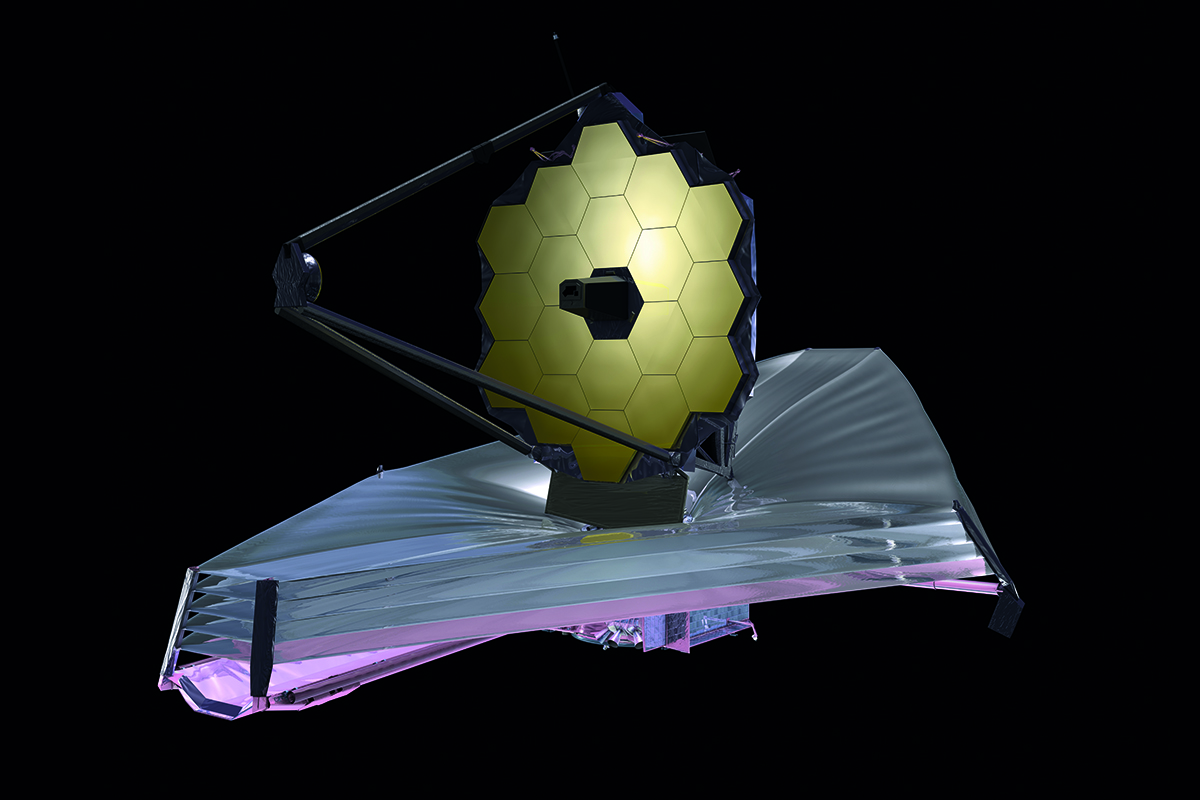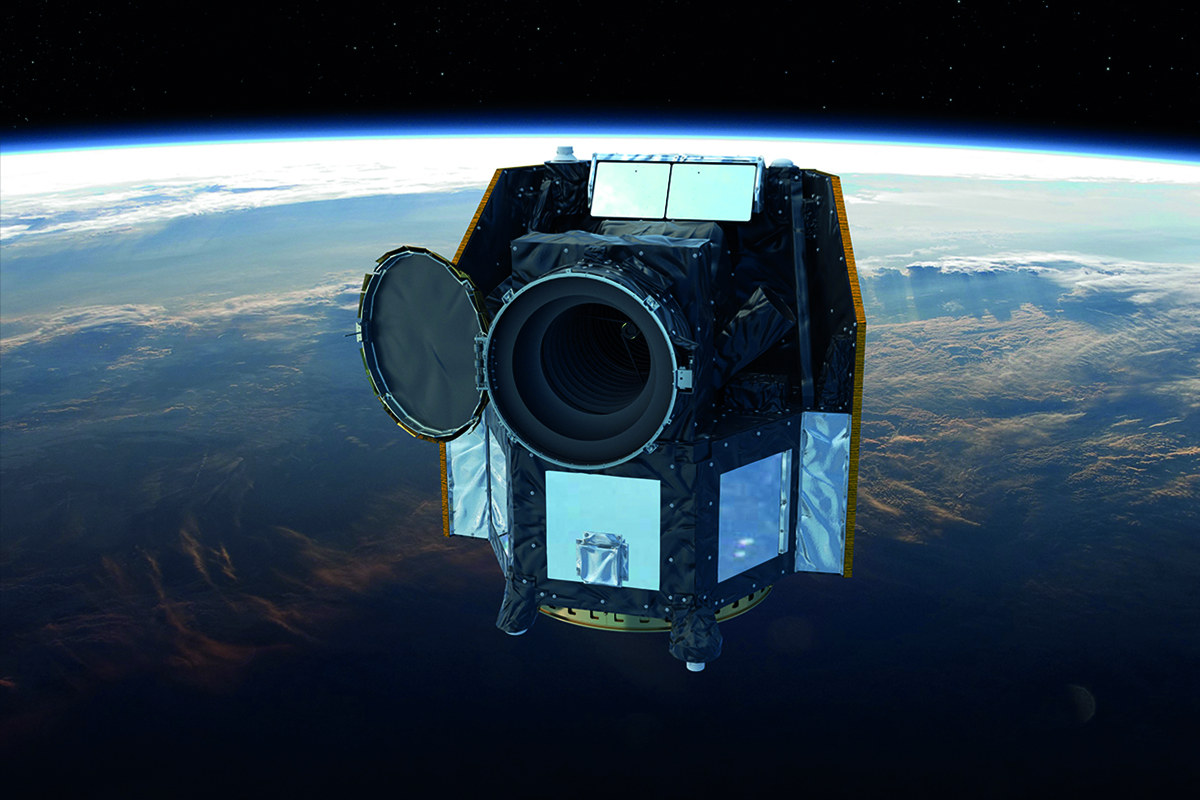Research with the $10 billion space telescope
Yann Alibert and Matthew Hooton are eagerly awaiting the planned launch of the James Webb Space Telescope (JWST) on December 22, 2021. In this interview, the two astrophysicists from the University of Bern tell how they managed to get observation time with JWST and what this has to do with CHEOPS.

Yann Alibert: I am studying how planets and planetary systems form and evolve. I am mainly a theorist and do computational work in order to make predictions about the interior of the planets and what they are composed of.
Matthew Hooton: I am observing exoplanets and more specifically the transits of exoplanets. When a planet happens to have an orbit that passes between its stars and us watching it, an amount of the light of the star is blocked by the transiting planet. And by measuring this amount, we can tell quite a few things about the planet and the star. It also gives us clues about what the atmosphere of an exoplanet is made of.
Why are the atmospheres of exoplanets so interesting?Yann Alibert: Well, there is obviously no question of travelling to exoplanets. Everything we know about exoplanets we know from their atmospheres. If we want to understand these planets, how they formed and evolved, we have to understand their atmospheres.
Matthew Hooton: As pointed out before, we use the transits to learn something about the atmosphere of an exoplanet. A fraction of the light of the star is filtered through the atmosphere of the planet when it passes in front of the star. If this filtered light is analyzed, conclusions can be drawn about the chemical composition of the atmosphere of the planet because different atoms and molecules in the atmospheres leave behind recognizable "fingerprints" in the light. We can work out all the different abundances of various molecules, such as water, carbon monoxide, or carbon dioxide for example. By using sophisticated atmospheric models we compare the abundances of molecules in the atmospheres of the planets in a system to each other and this gives us information about where in the formation disk of the system the planets formed.
You were involved in the paper about a unique planetary system that was detected with CHEOPS.Matthew Hooton: Three transiting planets in the system were originally identified by the TESS satellite. We then got eleven days of continuous CHEOPS observation because it was such an exciting system. This allowed us to correctly identify the orbital periods of the known planets and discover three previously unknown planets, bringing the total number of known planets in the TOI-178 system to six. The orbital periods that they have are in a very specific pattern that causes the planets to exert uncommonly strong gravitational forces on each other.
Yann Alibert:This is quite rare, and in terms of formation of the planets it would take a very specific history to get to that point. And the other reason the system is so interesting is that there is an irregular pattern of the densities of the planets. Usually, the further away a planet is from the star, the lower its density. This is not the case for TOI-178. So, once you put these two things together, it is really hard to explain how this system formed.
Now you have obtained time with JWST to observe that extraordinary system further.Yann Alibert: As pointed out before, we already know a lot about the system. The observations with JWST will bring on top of that information about the composition of three of the planets of the TOI-178-system.
Matthew Hooton: We will be observing one transit of three of the planets in the system. And each observation will last about six or seven hours. That will give us information of the atmospheres of three planets which are located at different points in the system.

Matthew Hooton: We didn’t have very high expectations because a lot of people were applying for observation time and obviously, they had very good science cases to propose as well. I have worked quite a few proposals for telescopes in the past. But JWST is just on a different level – also in making sure that everything is correct. We were thinking about science questions that we could answer with JWST. Not only did we have this really interesting system where there is some strange physics going on as it were, but the system was really favorable for observation. So, we had to go through a detailed check of the technical aspects of the observations and the exact sort of strategy we wanted to propose. We were then bringing in people from across the CHEOPS team who have the relevant expertise to define what was realistic. At the earliest we think the data could be taken hopefully by this time next year, that is in the second half of 2022.

Yann Alibert: A key thing with JWST is to exactly know beforehand what to observe and when. Thanks to CHEOPS, we exactly know the orbits of the planets in the TOI-178 system and when their transits will occur. It is indeed a good demonstration of why CHEOPS is so important. Its flexibility and high precision allowed us to confirm TOI-178 as an interesting system to be observed with JWST. With JWST you don’t even want to waste one hour waiting for a planet to transit. Time is very precious when it comes to something that cost billions to put up in space.
Working with the JWST seems like a dream come true. Yann once told me, he that he dreamt of becoming an astronaut as a kid as a lot of astrophysicists did. How about you, Matthew?Matthew Hooton: It is a bit embarrassing, but to be honest, I must have done it at some point as well. But the skills required to become an astronaut would be to be a very good soldier or very good at flying planes for instance. I guess I realized slightly later on that astronauts mainly have to follow a very strict set of orders. Which is on a certain level less interesting than what we do. We can work out the interesting questions that we want to answer. And I think that is one of the most appealing aspects of a job in research is that we can decide what we think is interesting and spend our time following that and trying to find answers. Although, I must admit, going to space looks fun.
About YANN ALIBERT

Yann Alibert is a theoretical astrophysicist, and the creator of the ‘Bern model’ to compute the formation and evolution of planetary systems. He did his studies at the Ecole Normale Supérieure de Lyon (France) in mathematics and theoretical physics, before a PhD in theoretical astrophysics. After his PhD, he moved to Bern where he received, in 2009, the first Swiss ERC grant in Astronomy. Since this time, he has been heavily involved in the setting up and running of the NCCR PlanetS. He is now Professor at the University of Bern, project leader and Science Officier in the NCCR PlanetS.
Contact:
Prof. Dr. Yann Alibert
University of Bern, Physics Institute, Space Research & Planetary Sciences (WP)
Email: yann.alibert@unibe.ch
ÜBER MATTHEW HOOTON

Matthew Hooton has been a postdoc at the University of Bern Physics Institute for the past two years. After studying physics at the University of Warwick in England, he completed his PhD at Queen's University Belfast in Northern Ireland, where he used ground-based telescopes to study the atmospheres of hot Jupiters. Since coming to Bern he has been primarily been analysing data acquired by the CHEOPS mission, with a particular focus on characterising compact, multi-planet systems and large planets orbiting hot stars. Earlier this year, a team led by Matthew successfully applied for time on the James Webb Space Telescope to perform observations that will study the dynamical history and atmospheres of the TOI-178 system, which are expected to happen late next year.
Contact:
Dr. Matthew Hooton
University of Bern, Physics Institute, Space Research & Planetary Sciences (WP)
Email: yann.alibert@unibe.ch
BERNESE SPACE EXPLORATION: WITH THE WORLD’S ELITE SINCE THE FIRST MOON LANDING
When the second man, "Buzz" Aldrin, stepped out of the lunar module on July 21, 1969, the first task he did was to set up the Bernese Solar Wind Composition experiment (SWC) also known as the “solar wind sail” by planting it in the ground of the moon, even before the American flag. This experiment, which was planned and the results analysed by Prof. Dr. Johannes Geiss and his team from the Physics Institute of the University of Bern, was the first great highlight in the history of Bernese space exploration.
Ever since Bernese space exploration has been among the world’s elite. The numbers are impressive: 25 times were instruments flown into the upper atmosphere and ionosphere using rockets (1967-1993), 9 times into the stratosphere with balloon flights (1991-2008), over 30 instruments were flown on space probes, and with CHEOPS the University of Bern shares responsibility with ESA for a whole mission.
The successful work of the Department of Space Research and Planetary Sciences (WP) from the Physics Institute of the University of Bern was consolidated by the foundation of a university competence center, the Center for Space and Habitability (CSH). The Swiss National Fund also awarded the University of Bern the National Center of Competence in Research (NCCR) PlanetS, which it manages together with the University of Geneva.
Zur Autorin
Brigit Bucher is Head of Media Relations and the “Space” representative at the University of Bern Communication & Marketing Department.